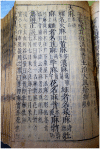Cannabis in Chinese Medicine: Are Some Traditional Indications Referenced in Ancient Literature Related to Cannabinoids?
- PMID: 28344554
- PMCID: PMC5345167
- DOI: 10.3389/fphar.2017.00108
Cannabis in Chinese Medicine: Are Some Traditional Indications Referenced in Ancient Literature Related to Cannabinoids?
Abstract
Cannabis sativa L. (Cannabaceae) has a long history of utilization as a fiber and seed crop in China, and its achenes ("seeds") as well as other plant parts have been recorded in Chinese medical texts for nearly 2000 years. While the primary applications of cannabis in Chinese medicine center around the use of the achenes, ancient indications for the female inflorescence, and other plant parts include conditions such as pain and mental illness that are the subject of current research into cannabinoids such as cannabidiol (CBD) and Δ9-tetrahydrocannabinol (THC). However, little previous research has been conducted to analyze the Chinese medical literature in light of recent advances in the pharmacology and taxonomy of cannabis, and most of the relevant Chinese historical records have not yet been translated into Western languages to facilitate textual research. Furthermore, many key questions remain unresolved in the Chinese literature, including how various traditional drug names precisely correspond to different plant parts, as well as the implications of long-term selection for fiber-rich cultivars on the medical applications of cannabis in Chinese medicine. In this article, prominent historical applications of cannabis in Chinese medicine are chronologically reviewed, and indications found in ancient Chinese literature that may relate to cannabinoids such as CBD and Δ9-THC are investigated.
Keywords: Cannabis; Chinese medicine; bencao; cannabidiol; historical changes.
Figures
Similar articles
-
Medicinal Applications of Cannabinoids Extracted from Cannabis sativa (L.): A New Route in the Fight Against COVID-19?Curr Pharm Des. 2021;27(13):1564-1578. doi: 10.2174/1381612826666201202125807. Curr Pharm Des. 2021. PMID: 33267756 Review.
-
Research Progress on Cannabinoids in Cannabis (Cannabis sativa L.) in China.Molecules. 2023 Apr 29;28(9):3806. doi: 10.3390/molecules28093806. Molecules. 2023. PMID: 37175216 Free PMC article. Review.
-
Comprehensive Review of Medicinal Marijuana, Cannabinoids, and Therapeutic Implications in Medicine and Headache: What a Long Strange Trip It's Been ….Headache. 2015 Jun;55(6):885-916. doi: 10.1111/head.12570. Epub 2015 May 25. Headache. 2015. PMID: 26015168 Review.
-
Determination of Acid and Neutral Cannabinoids in Extracts of Different Strains of Cannabis sativa Using GC-FID.Planta Med. 2018 Mar;84(4):250-259. doi: 10.1055/s-0043-124088. Epub 2017 Dec 13. Planta Med. 2018. PMID: 29237190
-
A randomised controlled trial of vaporised Δ9-tetrahydrocannabinol and cannabidiol alone and in combination in frequent and infrequent cannabis users: acute intoxication effects.Eur Arch Psychiatry Clin Neurosci. 2019 Feb;269(1):17-35. doi: 10.1007/s00406-019-00978-2. Epub 2019 Jan 19. Eur Arch Psychiatry Clin Neurosci. 2019. PMID: 30661105 Clinical Trial.
Cited by
-
Cannabis sativa: origin and history, glandular trichome development, and cannabinoid biosynthesis.Hortic Res. 2023 Jul 26;10(9):uhad150. doi: 10.1093/hr/uhad150. eCollection 2023 Sep. Hortic Res. 2023. PMID: 37691962 Free PMC article.
-
Evidence for Use of Cannabinoids in Mood Disorders, Anxiety Disorders, and PTSD: A Systematic Review.Psychiatr Serv. 2021 Apr 1;72(4):429-436. doi: 10.1176/appi.ps.202000189. Epub 2021 Feb 3. Psychiatr Serv. 2021. PMID: 33530732 Free PMC article.
-
Chemical Composition of Commercial Cannabis.J Agric Food Chem. 2024 Jun 26;72(25):14099-14113. doi: 10.1021/acs.jafc.3c06616. Epub 2024 Jan 5. J Agric Food Chem. 2024. PMID: 38181219 Free PMC article.
-
Secondary Terpenes in Cannabis sativa L.: Synthesis and Synergy.Biomedicines. 2022 Dec 6;10(12):3142. doi: 10.3390/biomedicines10123142. Biomedicines. 2022. PMID: 36551898 Free PMC article. Review.
-
Endocannabinoids in Body Weight Control.Pharmaceuticals (Basel). 2018 May 30;11(2):55. doi: 10.3390/ph11020055. Pharmaceuticals (Basel). 2018. PMID: 29849009 Free PMC article. Review.
References
-
- Ali M., Sai F., Wang X. Q. (2004). An investigation into the history of cannabis prohibition in Xinjiang. J. Xinjiang Univ. Soc. Sci. Edn. 32, 79–82.
-
- Brand E., Wiseman N. (2008). Concise Chinese Materia Medica. Taos, NM: Paradigm Publications, 51–52.
-
- Chen S. L., Gilbert M. G. (2006). Flora of China. St Louis, MO: Science; Beijing and Missouri Botanical Garden Press.
-
- Chen Z. M., Huang S. B. (2005). Materia Medica Literature. Nanjing: Dongfang University Press, 235–237.
-
- Chinese Pharmacopoeia Commission (CP) (2015). Pharmacopoeia of the People's Republic of China, 2015 Edn. Beijing: China Medical Science Press.
Publication types
LinkOut - more resources
Full Text Sources
Other Literature Sources





